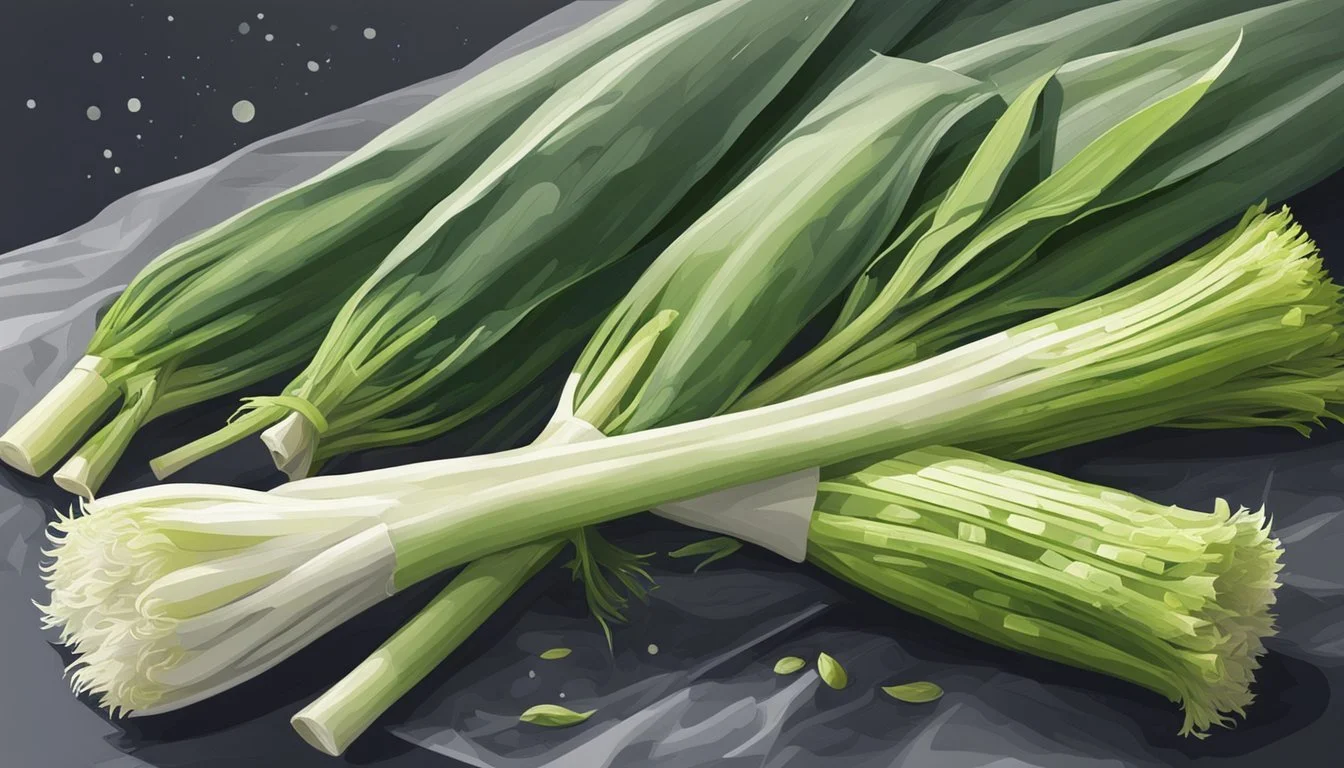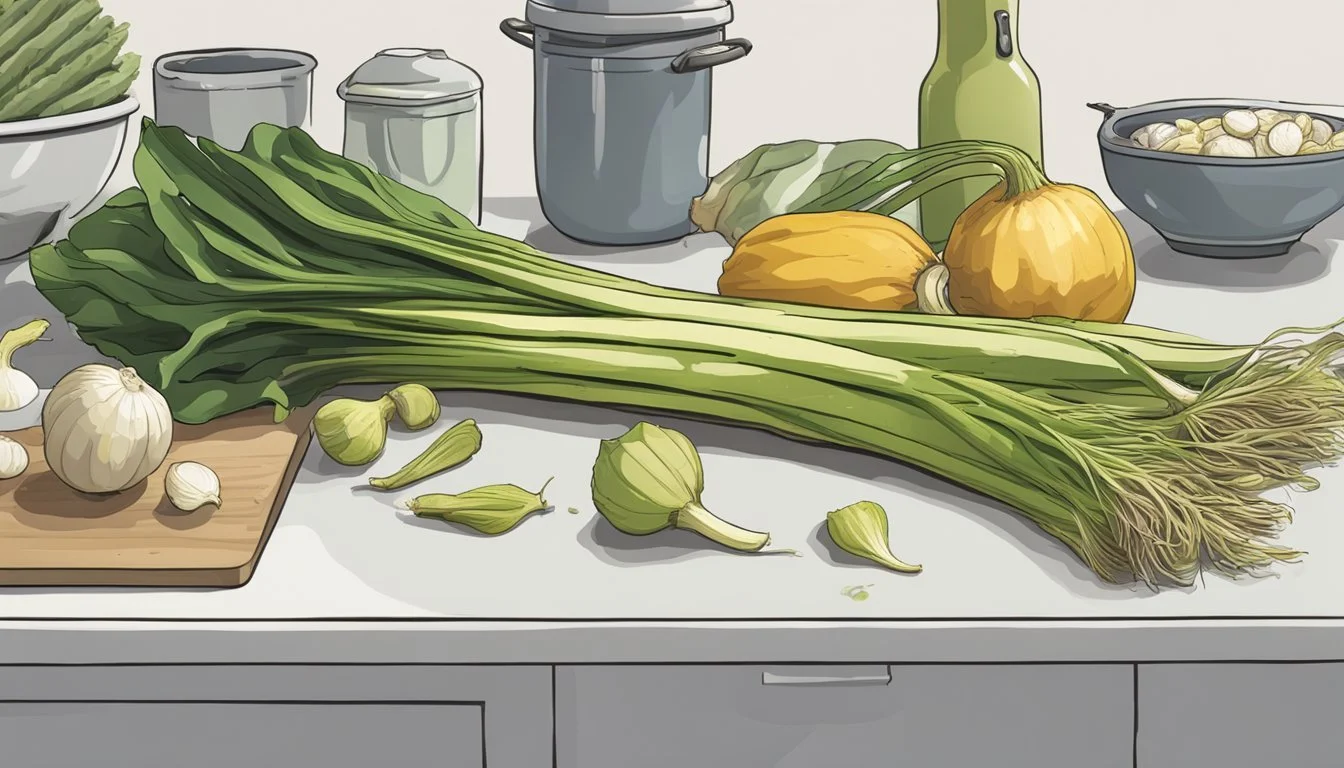How Long Do Leeks Last?
Understanding Their Shelf Life and Storage Tips
Leeks, a versatile vegetable related to onions and garlic, are a staple in many kitchens due to their mild flavor and ability to enhance a wide range of dishes. To make the most of their culinary potential, understanding their shelf life and the factors that influence it is essential. Generally, leeks can last up to two weeks when stored properly in the refrigerator's crisper drawer, with the roots attached and the vegetable left unwashed to maintain freshness.
The shelf life of leeks isn't just determined by how they're stored — it's also influenced by their state when purchased. Fresh, firm leeks with crisp, upright leaves are more likely to last the full two weeks, while those that have begun to wilt may have a considerably shorter shelf life. For those who seek to extend the longevity of their leeks even further, freezing offers an excellent option. When leeks are cleaned, cut, and frozen, they can be kept for extended periods, although they are then best used in cooked preparations like soups or stews, as their texture changes when thawed.
Understanding the proper storage techniques for both whole and cut leeks can eliminate food waste and ensure that these flavorful vegetables are available to enhance meals when needed. Whether kept in the refrigerator for immediate use or frozen for future dishes, managing the shelf life of leeks is an important aspect of kitchen savvy.
Identifying Fresh Leeks
When selecting leeks from the produce section, one should look for indicators of peak freshness. Fresh leeks are members of the allium family, and they showcase a firm and smooth texture. The white portion of the leeks should be bright and unblemished, while the roots at the base are typically crisp and intact. Fresh leeks will also exhibit vibrant green leaves that are uncompromisingly stiff and upright.
Optimal Characteristics of Fresh Leeks:
Texture: The stalk of a fresh leek should be firm to the touch, resembling the texture of a fresh onion or cucumber.
Coloring: A gradient from bright white at the base to a dark green at the upper leaves indicates a fresh leek. Any signs of yellowing or browning may denote age or damage.
Odor: They should have a mild, sweet scent typical of the allium family. An absence of odors or a distinctly unpleasant smell can signal spoilage.
Roots: The presence of small, hair-like roots at the base are commonplace and signify fresh produce.
Visual and Tactile Indications of Freshness:
Leaves are tightly rolled and snappy.
No visible wilting or withering.
Absence of cracks or bruises along the white body.
Leeks should not only be firm and fresh in appearance but also free from any pungent or sour odors – a hallmark of the allium family's sweet, mildly onion-like aroma when fresh. Always inspect leeks thoroughly to ensure that one is choosing the freshest options for culinary use.
Proper Storage Techniques
Storing leeks correctly is essential to maintain their freshness and extend their shelf life. Employing both short-term and long-term storage techniques can allow you to enjoy leeks at their best for weeks or even months.
Short-Term Storage
For short-term storage, leeks should be kept in the refrigerator. Unwashed leeks can be placed in the crisper drawer, which is ideal for preserving the moisture levels that vegetables like leeks need. Wrapping the leeks loosely in a damp paper towel before placing them into a plastic bag can further help to retain moisture. This method will typically allow leeks to last for up to two weeks.
Long-Term Storage
Freezing is a reliable method for long-term storage of leeks. Before freezing, one should first blanch the leeks to preserve their color, texture, and flavor. Cut the leeks, blanch them in boiling water for 1-2 minutes, and then plunge them into ice water to halt the cooking process. After drying, spread the leeks on a baking sheet to freeze them individually. Once frozen, transfer the leeks to a freezer bag or an airtight container, removing as much air as possible. Frozen leeks can last for several months.
Alternative Methods
Leeks can also be stored in a cool and dry place such as a root cellar or cool basement, which can be effective for fresh leeks. Additionally, preserving them through canning or pickling can extend their usability while adding flavor. Drying leeks is another alternative method, suitable for a dry, well-ventilated space like a kitchen cabinet. Each preservation method contributes differently to storage time and texture of the leeks.
Usage and Cooking Recommendations
When using leeks, it is important to prepare them correctly to maximize their flavor and texture. Whether leeks are being added to a soup or served as a side dish, understanding how to properly cut and cook them ensures the best culinary experience.
Preparing Leeks for Use
Leeks should be thoroughly washed before use to remove any dirt caught between the layers. They are typically cut into slices or used whole, depending on the recipe. The white and light green parts are most commonly used as they are more tender, while the dark green tops can be used for stock.
Cooking with Leeks
Leeks can be cooked in various ways, including braised, stewed, and sautéed in butter. They contribute a sweet and mild onion-like flavor to dishes, making them a versatile ingredient. Leeks are often used in salads, soups, and stews.
Salads: Raw leeks should be finely sliced and added to salads for a crunchy texture and a hint of onion flavor.
Soups and Stews: Leek soup, for instance, showcases the leek's soft texture when stewed. They should be sautéed until tender before being added to liquid bases.
Braised: To butter-braise leeks, they should be cooked until they are very soft and sweet, excellent as a side dish.
Mushy Avoidance: Overcooking leeks can make them mushy. To maintain a pleasant texture, it's crucial to cook them just until they become tender.
Leeks are a healthy addition to a diet as they are a nutritious vegetable that pairs well with various ingredients in a myriad of recipes, from leek soup to sauces.
Recognizing Spoilage
Recognizing spoilage in leeks is primarily through visual examination and sensory evaluation. It's important for the reader to be aware of these cues to ensure they use leeks that are safe and of good quality.
Visual Indicators
Spoilage in leeks can often be identified through visual inspection. When examining leeks:
Yellowing: Fresh leeks should have vibrant green tops. Yellowing of the leaves is a indication they are past their prime.
Mold: White or black spots may signify the presence of mold. Any leek with signs of mold should be discarded.
Wilted Tops: The tops of the leeks may become limp and wilted, indicating they are no longer fresh.
Discoloration: Any other discoloration, especially darkening to a brown hue, suggests the leek is old and possibly spoiled.
Texture: Fresh leeks have a firm texture. If the leek feels soft or mushy, it may be rotten.
Olfactory and Textural Cues
One's sense of smell and touch are crucial in identifying leeks that have gone bad.
Odor: A foul or sour odor is a strong indicator that the leek has gone bad.
Slimy: If the leek has a slimy film on its surface, it has likely begun to rot.
Softening: Leeks should be firm to the touch. When they become tender or soft, they have lost their crispness and are no longer fresh.
Toughness: Oddly, if the outer layers of the leek become unusually tough, it can also signify age and deterioration.
The reader should discard any leeks that exhibit these spoilage signs to ensure the quality and safety of their meals.
Optimal Conditions for Leeks
Proper storage extends the shelf life of leeks by providing the right temperature and humidity levels. Both harvest and post-harvest handling are critical to maintaining freshness.
Temperature and Humidity
Leeks thrive in cool and moist storage conditions. For refrigerator storage, placing them in the crisper drawer is optimal, as it typically offers a more regulated environment designed to maintain an appropriate balance of cold air and humidity. The ideal temperature for storing leeks in a refrigerator is between 32°F (0°C) and 40°F (4°C), which can keep them fresh for up to two weeks. A freezer can be used for long-term storage of up to one year when leeks are properly prepared prior to freezing. It's essential to avoid warmer temperatures or fluctuating conditions, as they can accelerate spoilage.
Freshness Tip: To retain freshness and texture, store leeks unwashed with the roots intact, since washing can introduce moisture that might hasten decay.
Harvest and Post-harvest
The way leeks are handled from the moment of harvest influences their shelf life. Leeks should be harvested with care, keeping the roots and stems intact. Once harvested, they should be kept in a cool and dry place if not immediately refrigerated. Avoid cleaning off dirt from the roots and stems, as the soil can help protect the leeks from dehydration and spoilage. Trim the roots to about 1 inch and leave up to 6 inches of the green tops.
Storage Tip: If storing leeks at room temperature, they should be used within 3 to 5 days, as they last much longer in colder conditions.
By adhering to these suggested temperature and humidity standards and observing the proper post-harvest care, one can significantly increase the shelf life of leeks, ensuring they remain a crisp and flavorful addition to culinary creations.
Maximizing Leek Lifespan
To extend the shelf life of leeks, one should start with selecting fresh harvests, characterized by crisp, green leaves and firm stalks without wilting. Proper storage is crucial for maintaining their freshness.
In the fridge: Leeks can last up to two weeks when stored correctly in the refrigerator. It is advisable to wrap them loosely in a plastic bag to retain moisture and place them in the crisper drawer. This helps to keep them from dehydrating and preserves their quality.
In the freezer: For longer-term storage, leeks can be sliced and then frozen. They should be spread on a baking sheet and frozen uncovered for about an hour until crisp. They can then be transferred to an airtight container or sealed plastic bag, eliminating excess air before placing back in the freezer.
Storage Method Approximate Lifespan Room Temperature 3-5 days Refrigerator Up to 2 weeks Freezer Several months
Maintaining the right moisture levels and using airtight containers when freezing can greatly affect the leeks' shelf life. It's important to avoid washing until ready to use, as excess moisture can promote spoilage. Lastly, trim only the roots and remove the outer layer before cooking to ensure the leeks remain at optimal freshness.








